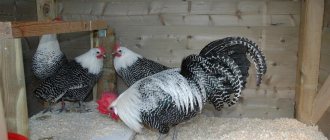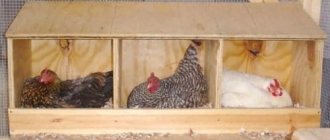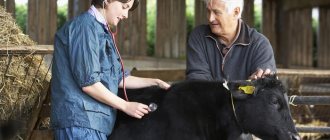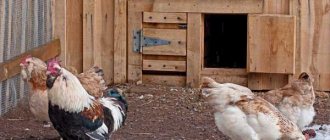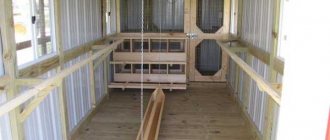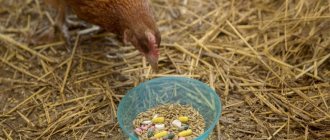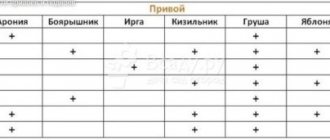How to insulate a chicken coop so that chickens lay eggs in winter
In most cases, a chicken coop made of boards is insulated from the outside, but in recent years many chicken breeders have insulated the chicken coop from the inside with polystyrene foam. The advantages of such insulation:
- there are no drafts in the chicken coop (it is easier for laying hens to withstand the cold than drafts);
- polystyrene foam does not get wet and does not rot;
- the chicken coop becomes noticeably warmer.
There are only two disadvantages: mice can live in the foam and chickens love to peck at it. The best way to protect polystyrene is to plaster it or cover it with plywood. Cement plaster does not adhere well to foam plastic, but there is a way out. You must first plaster the foam sheets, wait three days, secure them to the wall with mushroom dowels and re-plaster them.
In our participant with the nickname Alexander ZYAB, chickens have been wintering in a chicken coop, built from “twenty” boards and insulated from the inside with polystyrene foam, for many years. The heater turns on only in severe frosts.
But such thermos chicken coops require good ventilation. This will help avoid high humidity. According to the experience of our users, the best heater for a chicken coop is a convector with an electronic thermostat: it allows you to set the correct temperature and save energy.
The recommended convector power is 1 kW per 10 sq. m. chicken coop.
The photo shows how the heating of the roost area is arranged (the rest of the chicken coop is not heated). This is a 1.5 kW micathermic heater.
There is a way to do without a heater. Chickens at home winter well on deep litter. Deep litter pie (from floor to ceiling, per 1 square meter of area):
- 1 kg of lime (even layer);
- 10 cm of straw (can be replaced with sawdust).
This is the initial, starting layer of litter. The chickens will trample it down, and the chicken keeper’s job is to stir it up with a pitchfork from time to time and add fresh straw or sawdust. In order for chickens to lay eggs in winter, not get sick and easily survive the winter, such a “natural heat generator is enough”, the main thing. So that the chicken coop is insulated and there are no drafts in it. Chickens traditionally winter on deep litter in Siberia and the Urals.
How to prepare a chicken coop for winter cold?
The first stage of the insulation process is the selection of a suitable material. The most common are: penoplex; Styrofoam; mineral wool; foil penofol.
The latter option is more budget-friendly, but they all have one function - they retain heat indoors. Which material to choose is a purely individual decision, since their main difference is only in the structure.
The insulation process itself takes place in several stages:
- Floor insulation. The bedding layer on the floor can be made of various organic materials. Straw, hay, peat, moss, sawdust and shavings are used for these purposes: they are best suited for floor insulation, are safe, affordable, and after use can be used as fertilizer on the floor. plot. The layer thickness should be at least 20 cm. As the material cakes, it is necessary to add 5-10 cm of filler. A complete replacement of the insulation is carried out at the end of the season.
- Insulation of walls. The outside walls are insulated with foam blocks, and on top with plastic sheets or slate. If the climate for keeping birds is harsh, then the inside of the room can be lined with foam blocks.
- Insulation of the roof and ceiling. As for the roof, there are no special requirements. It is important that there are no cracks or breaks in it. If there is an attic above the poultry house, it is recommended to lay it with a thick layer of straw.
- Insulation of doors and windows. Doors and windows should not allow air to pass through or create drafts. To do this, it is enough to cover them with old thick blankets or blankets (several layers if necessary).
Additional lighting
Reducing daylight hours directly affects the egg production of chickens. If additional lighting is not provided in the poultry house during the cold season, the productivity of the birds will be minimal or even zero.
When organizing additional lighting, you must adhere to some important rules:
- To increase daylight hours inside the chicken coop, you can use LED, fluorescent or ordinary household incandescent lamps.
- With excess lighting, birds become restless and fight more, so it is important not to overdo it in organizing winter lighting. For 10 square meters of room, one 60 W light bulb will be enough.
- It is best to install the light bulb under the ceiling in the area with feeders - this will create the most comfortable conditions for the chickens.
- It is necessary to turn on the lighting in the morning (at 5–6 o’clock) and turn it off when full daylight begins. In the evening, as soon as it begins to get dark, you can turn on the lamp again and leave it working until 8–9 pm. This process can be greatly simplified by purchasing a timer at a hardware store, which will automatically turn the lighting on and off according to a given schedule.
Balanced nutrition for laying hens in winter
Proper nutrition in the required quantity greatly influences the productive performance of the bird.
Therefore, in winter it is important to plan the diet of chickens based on a number of rules:
- In the summer, it is necessary to dry various herbs (nettle, clover, chicken millet), tie the preparations into small bunches and hang them not high above the floor.
- Add boiled root vegetables (beets, zucchini, carrots, potatoes, pumpkin) to the chickens' diet.
- Prepare special mash, which includes crushed eggshells, bone or fish meal, bran, sunflower cake. This supplement will provide the birds with all the missing substances.
- Bloodworms or worms can be added to the diet as a source of additional protein and calcium in the diet.
- In separate containers in the poultry house there should be chalk, small gravel, and crushed shells.
- Water for drinking in winter must be heated to the optimal room temperature.
By creating all the necessary conditions in the poultry house, as well as adjusting the poultry’s diet, you can achieve good productivity indicators and get high-quality eggs even in winter.
The main thing is to follow simple and few rules, and then the birds will be healthy and happy.
Keeping chickens in winter: how to increase daylight hours
Chickens lay eggs not for our pleasure, but for procreation. When daylight hours are greatly reduced, chickens’ desire to reproduce is also greatly reduced - winter is just around the corner! Chicken organisms mistake the additional lighting for spring and begin laying eggs again.
Ideally, daylight hours should last 14 hours. No more, domestic chickens must rest in winter. It is enough to turn on the light twice a day:
- in the morning from 6 to 9 o'clock;
- in the evening from 18 to 21 hours.
The main thing is that the lighting is not too bright. For a small chicken coop, one energy-saving light bulb of 5-7 watts is enough.
KazimirchukForumHouse Member
At the beginning of my poultry farming, 50 chickens died due to improper lighting. They often began to lay very large eggs, the oviducts became inflamed, and the bird died.
Domestic chickens respond best to infrared lamps in winter, but prefer to lay eggs in dark corners. This is where nests should be built.
Age of chickens suitable for egg production
Despite the fact that the life expectancy of chickens is from 12 to 14 years, the most active period of egg production is a young age, up to a year. Fertile individuals are capable of producing up to 300 eggs per year. After a year, egg production decreases by an average of 10%, and after 5-7 years it disappears completely. Periods of complete absence of egg production appear, which are called, as mentioned above, molting.
At large rural enterprises, chickens are kept exclusively for up to a year, precisely during the period of their maximum egg production, and at one and a half years they are sent to slaughter, because there is no financial sense in keeping a bird that produces a small number of eggs or does not lay them at all.
If the farm is smaller, then the owner can keep chickens up to the age of 2 or even 3 years. However, then the chickens are also sent to slaughter, since after 3 years the egg production rates drop much more rapidly than after a year.
As for roosters, they are kept for no more than 4 years, as long as their sexual activity lasts.
At a young age, chickens lay small eggs, which are assigned a low grade (C2 and C3). But nevertheless, these are the eggs that are considered the healthiest.
What to feed chickens in winter
In winter, the chickens' diet changes - fresh greens disappear from it, and it should become more nutritious. Here is a classic basis from which to build.
Domestic chickens should receive this mash twice a day in winter, and textbooks on poultry farming recommend giving grain to laying hens at night.
Our portal user Pletnev found a budget version of the diet for laying hens. He gives his birds three times a day a potato-based mash from the ingredients listed in the table. Laying hens receive grain only in frosty conditions. According to his experience, you can feed chickens in winter like this (data is given for one laying hen per day in grams):
| Compound feed | 45 |
| Boiled potatoes | 65 |
| Hay | 12 |
| Chalk (gravel) | 5 |
| Waste fish or meat | 3 |
You cannot replace water with snow in winter - laying hens must drink.
And you can’t overfeed chickens - obesity reduces egg production.
Video tips for increasing egg production of chickens
We present to your attention a video in which an experienced breeder shares his secrets for improving the egg production of chickens:
When using these tips for improving the egg production of chickens, keep in mind that they only apply to healthy representatives, because there are reasons for a decrease in egg production that have nothing to do with the change of season. And if the problems are related to diseases, then these recommendations will not help solve the problem - then you will need to contact a veterinarian.
0
0
Copy link
Keeping chickens in a greenhouse in winter
Wintering chickens in polycarbonate greenhouses is quite acceptable if there is no permanent chicken coop.
Chickens will be quite comfortable in such a room. The necessary conditions:
- very deep litter, at least 40 cm;
- necessary equipment (perches);
- Heater – Heating will most likely be needed at night.
Chickens, depending on the breed, can withstand short-term exposure to sub-zero temperatures down to -12 degrees. But it's better to avoid this.
If it is possible to place blocks of hay along the walls of the greenhouse for insulation, this would be simply ideal.
A member of our portal with the nickname mielena, whose laying hens lived in a greenhouse in winter, prepared for this in the following way:
- sealed all possible holes in the ground to prevent rodents from entering;
- laid a thick mat of straw and leaves on the floor;
- insulated the greenhouse from the inside with empty bags;
- arranged lighting and heating:
MielenaForumHouse Member
I connected 3 lamps (250+150+250) W in parallel to the thermostat (set to +10) at a distance of 100 cm, at a height of 120 cm from the floor.
What temperature do chickens tolerate in winter?
Chickens are unpretentious poultry that can quickly and well adapt to any conditions. In summer, they can walk outside from early morning until almost dark, getting food for themselves. The main conditions that need to be provided are a clean chicken coop with comfortable perches for sleeping and resting, as well as fresh water.
In winter, if chickens are kept for meat or for breeding, you won’t have to worry much about their maintenance either. It’s another matter if chickens are required to produce good eggs. Here, it is impossible to do without providing special conditions, including accommodation in warm temperatures.
Did you know? Laying hens can lay eggs only in daylight or artificial light. If the time of laying eggs happened at night, the bird will delay the process until morning comes or the lights turn on.
In the chicken coop
It is recommended that the temperature in the poultry house should not fall below +15 degrees Celsius. Chickens can tolerate sub-zero temperatures, but exposure to them for a long time has a detrimental effect on egg production.
Therefore, keeping laying hens in winter becomes impractical, because at this time the amount of feed required and the cost of electricity required for lighting increase.
At temperatures below 10 degrees below zero, frostbite may occur on the earrings and combs. In order to protect them, it is necessary to lubricate them with Vaseline, a natural fat.
We recommend that you learn how to build a winter chicken coop with your own hands.
On a walk
Chickens can be released to roam at temperatures down to minus 10 °C. The lower the temperature, the shorter the walk should be. Walking for a long time in the cold does not have the best effect on egg production. It will be enough to release the birds for no longer than 2 hours a day. In bad, windy, snowy, or icy weather, walks may not be necessary to avoid injury and colds to the birds.
Summarizing
Chickens can lay eggs well in winter and pay for their maintenance if you take care of it first:
- insulate the chicken coop with polystyrene foam;
- make deep litter;
- install energy-efficient heaters.
- make reasonable lighting for the chicken coop.
Keeping domestic chickens in winter in an uninsulated chicken coop, with drafts and no additional lighting, is a costly and dangerous business. The chickens will not lay eggs and, quite possibly, will not survive until spring. If the poultry farmer takes care of the laying hens, he will be guaranteed excellent domestic eggs throughout the winter!
At FORUMHOUSE you can learn more about how to organize the keeping of laying hens in winter and how best to heat the chicken coop with heating devices. Read our articles on what to do to encourage chickens to lay eggs in winter and summer, and how to achieve a bright yellow yolk in your eggs. And watch our video on how to organize wintering for chickens in the garage.
Subscribe to our Telegram channelExclusive posts every week
Heating the poultry house in winter
In regions with frosty winters, insulation of the poultry house and deep litter will not be enough to maintain the optimal temperature (Figure 5).
In this case, farmers use various heating devices:
- Potbelly stove: the easiest and cheapest way to heat a chicken coop. But it should be remembered that the use of such a stove requires the installation of a chimney and constant monitoring of the combustion process. In addition, you will have to prepare a sufficient amount of fuel for the winter, although many rural residents successfully burn not only firewood, but also various garbage and household waste in potbelly stoves.
- Household heaters: conventional air heaters, convector and oil heaters are also perfect for heating a small chicken coop. These devices operate on electricity and do not need to be connected to a chimney. In addition, the owner of the livestock can install a thermostat that will automatically start the device when the temperature in the poultry house drops significantly.
- Infrared lamps and heaters: the advantage of these devices is that they heat not only the air, but also objects in the room. These devices consume little electricity, but only heat a certain area of the building, so in a large poultry house you will have to install several heaters at once.
Figure 5. To heat the chicken coop, you can use both conventional stoves and heaters, and modern infrared devices.
If the poultry house is adjacent to a residential building, water heating can be installed in it. To do this, simply extend a pipe into the building through which hot water will be supplied from the boiler. This method is considered one of the simplest, safest and most cost-effective.
You can find even more useful information about keeping chickens in winter, insulating the poultry house and the optimal temperature in the chicken coop in winter in the video.
Chickens do not lay eggs during molting
Chickens usually begin laying eggs at five months of age. After about eleven months, they begin molting, which lasts from one to four months (the duration depends on the breed and conditions of detention). There is no need to wait for eggs during molting, here you just need to wait. So, if you bought one-year-old chickens in the hope that they would lay eggs better than the young ones, then you clearly miscalculated: after a couple of months, the purchased birds will stop producing eggs. But five-month-old chickens, if kept well, will pay for themselves very quickly.
Chicken coop lighting
For poultry productivity, 13-14 hours of illumination is important, as in the summer season. In winter, in the chicken coop from 5 o'clock in the morning it is necessary to turn on artificial lighting until daylight begins, in the evening, when it gets dark, turn it on again until about nine in the evening. You can use a timer to make adjustments.
In a small chicken coop of 10 - 12 squares, one 40 W light bulb is enough.
Where is the best place to install the lamp? In the center of the chicken coop, closer to the feeders, so that feeding and resting areas on the roosts are illuminated. And where the chickens will nest, there should be a dark place. There is no need to illuminate the room for more than 14 hours; birds must rest without lighting, otherwise they will worry and fight.
You can use any light bulbs - fluorescent, LED, ordinary light bulbs, preferably 40 W (maximum up to 60 W in a spacious chicken coop).
Attention
.
Additional lighting is not required if the chicken coop is heated with infrared lamps; they also create the necessary lighting.
Ventilation in the barn
In the process of life, birds produce heat and moisture; regular ventilation is often not enough. Then condensation can accumulate in the room, which leads to the formation of bacteria and fungus. It is unacceptable to keep the bird in damp conditions; proper ventilation is required. Its arrangement will ensure an influx of fresh air, evaporation of excess moisture and vapors, and maintain the required air temperature.
What ventilation system is best to organize?
Natural ventilation (daily airing), as already mentioned, is often not enough. Moreover, in cold weather this can create dangerous temperature changes and drafts.
Supply and exhaust ventilation is a popular option; when keeping 20 or more chickens, it is better to install it from the very beginning. In a small chicken coop, it is enough to install a vertical pipe in the ceiling of sufficient length for exhaust.
Mechanical is suitable for industrial poultry farming, as it is expensive and the energy costs are significant.
Important
.
It is advisable to organize ventilation with a damper so that it can be closed during severe frosts.




